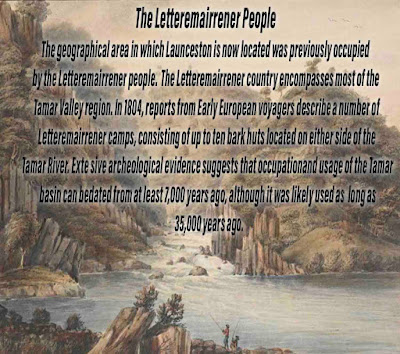A COUTER DRAFT FOR CONSIDERATION
When thinking about 'Launceston' as a 'place' we need to acknowledge the layers of histories and cultural landscaping that is now deeply embedded in the city's placedness.
The first inhabitants of the land that is now Launceston were the Aboriginal Tasmanians, the letteremairreener people, believed to have been part of the North Midlands Tribe.
The first European visitors did not arrive until 1798, when George Bass and Matthew Flinders were sent to explore the possibility that there was a strait between the Australian mainland and Van Diemen's Land – lutruwitaTasmania.
Bass and Flinders originally landed at the mouth of the kanamalukaTamar, 40 kilometres 'upriver' to the north-west of Launceston. It is now understood that the land around the confluence of the three waterways and the waterways where the City of Launceston now stands was known to the letteremairreener people as ponrabbel.
There are two quite distinct understandings of the place where the City of Launceston now stands. It is timely that the two now come together in order that both can inform each other about a new and more inclusive way forward. That will need to be an ongoing collaborative effort.
A 'civic partnership' is built upon a strong desire and responsibility to respond to community needs and aspirations. This includes advocacy and facilitation roles regarding Aboriginal histories, shared cultural heritage and the contemporary expressions of cultural placemaking. Community health, wellbeing and economic issues will always be deeply embedded a city's cultural landscaping and looking forward this must now include the accommodation of diverse and multilayered cultural sensibilities.
For some time now, the City of Launceston has been on a journey of understanding and learning in regard to a diversifying cultural reality in the city. This is a partnership plan to do far better in the future in regard to paying attention to palawa/pakana sensibilities and sensitivities.
The city looks to a future where its governance will continue to listen and learn from the cultural realities in evidence within the community and in particular palawa/pakana sensibilities that are increasingly evident.
In recent times Launceston City Council, has made a number of symbolic gestures in regard moving forward on a journey towards more inclusive governance and the acknowledgement Aboriginal cultural realities. For instance:
- The City now flies the Aboriginal flag over Town Hall - permanently.
- During recent NAIDOC Week celebrations, the Aboriginal flag was joined by the Torres Strait Island flag - flying above both Town Hall and the Queen Victoria Art Gallery at Royal Park; and
- Importantly, the city no longer supports the celebration of Australia Day activities on January 26 - a day that Council recognises is distressing to many people in our community; and
- The city is now taking steps to urge the Federal Government to release the city and all other local government authorities across the nation from holding citizenship ceremonies on January 26.
Likewise, as a community, 'Launcestonians' need to engage more effectively with local palawa/pakana people.
It is also important to acknowledge that the city's governance has not always effectively engaged with Aboriginal People in its past decision making. This has sometimes led to outcomes that have not been supported by various members of the Aboriginal community.
In short, as a Council, the city wants this to change and Council has identified the need to have a more meaningful partnership with the Aboriginal community and palawa/pakana people.
The City of Launceston Council believes that when the 'partnership' is embraced by the city's palawa/pakana people the 'partnership agreement' will be a significant step forward for Tasmania’s local government sector. It will be something that will enable the city to celebrate, acknowledge and recognise:
- The city's shared histories and the diverse cultural realities at work in the place now known as Launceston; and
- The achievements and the culture realities of Aboriginal People - because it is Australia’s true, original and unbroken cultural reality.
The 'Partnership Plan' thus far has evolved through various conversations with a range of palawa/pakana people in Launceston and surrounds. Throughout the process, a number of themes and focus areas emerged as being particularly relevant and important to the development of the city's sense of place and wellbeing.
Practically, the city's Councillors, planners and civic officers will remove the hurdles and create dialogue with palawa/pakana people on proposed significant maintenance work, capital works, civic planning, governance strategies, service provision, policy changes and anything else that may impact on the lifestyle or amenity of Launceston's Aboriginal residents.
Consistent with the City of Launceston's Community Engagement Framework, Council will focus on three key areas to enable the city to accommodate change via:
1. Continuous improvement in regard to community engagement and consultation; and
2. The ongoing building of internal capacity; and
3. The development of an effective and inclusive communications network.
In doing so, the City of Launceston's Council has made a commitment to employing more Aboriginal People to enable more expansive and shared understandings of Launceston's placedness.
Likewise, the city now makes a commitment to seek greater truth-telling, openness and transparency in all of its dealings with Aboriginal People.
The City of Launceston Council believes that it is incredibly important that, as a city, Launceston's broader community embraces change while developing better understandings in regard to just what the city stands for in a 21st Century cultural context. Moreover, the city aspires to provide more respectful leadership for all the people who think of the city as their 'homeplace'.




No comments:
Post a Comment